Introduction
Chihuahua puppies are tiny bundles of energy, typically weighing 1-6 pounds and standing 5-8 inches tall. Known for their petite size, these adorable pups have large, expressive eyes, erect ears, and delicate features that give them a charming, almost doll-like appearance. Have you ever met a dog which ladies can keep in their purse, but can even defeat a lion in confidence? That’s it, Chihuahua! These little furballs are not only fierce, but are full of love and have full attitude. Whether you live in a small house or in a big apartment, a Chihuahua puppy brings a full dose of laughter, loyalty, and personality in your life.”
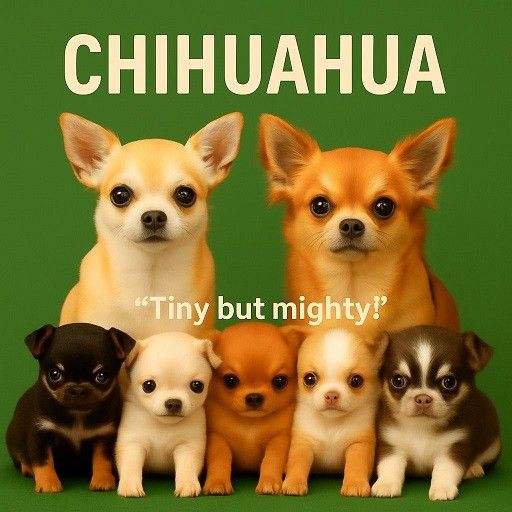
Table of Contents
History and Origins of the Chihuahua Puppies

From Ancient Mexico to Modern-Day Living Rooms
A Chihuahuan dog originates from Mexico and is said to descend from the Techichi dogs kept by the Toltec civilization in 900 AD. The Aztecs then adopted these tiny dogs as sacred companions.
The Sacred Dog of the Aztecs
Chihuahuas were considered spiritual guides. They were often buried with their owners, believed to help guide souls to the afterlife. Pretty intense for such a tiny pup, right?
Chihuahua Puppies Breed Overview

Recognized Standards Of Chihuahua Puppies
Recognized by the American Kennel Club (AKC), Chihuahuas fall under the toy group. Despite their size, they’re no lap pushover—they rank high in alertness and sass.
Teacup vs Standard Chihuahua Puppies
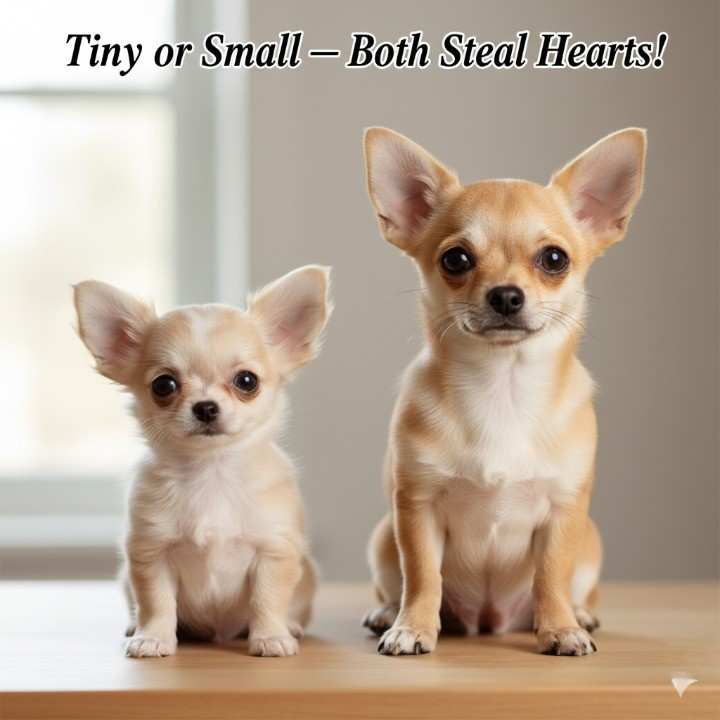
“Teacup Chihuahua” isn’t officially a breed standard. These are just extra-small Chihuahuas, weighing under 3 pounds. They’re super cute but often face more health challenges.
Physical Characteristics Of Chihuahua Puppies
Chihuahua Puppies Lifespan Overview
| Type | Average Lifespan |
|---|---|
| General Chihuahua | 14 – 17 years |
| Apple Head Chihuahua | 14 – 18 years (with good care) |
| Deer Head Chihuahua | 15 – 20 years (often slightly longer) |
| Teacup Chihuahua | 7 – 12 years (more fragile) |
🐾 Record Holder: The oldest known Chihuahua lived to be 23 years old!
Factors That Affect Chihuahua Puppies Lifespan
| Factor | Impact on Lifespan |
|---|---|
| Genetics | Healthy breeding = fewer inherited conditions |
| Diet | Balanced, high-quality food extends life |
| Exercise | Daily activity helps maintain a healthy weight and heart health |
| Dental Care | Poor dental hygiene can shorten lifespan due to infections |
| Vet Checkups | Regular checkups catch illnesses early |
| Vaccinations | Prevent deadly diseases like parvo, rabies |
| Spaying/Neutering | Can reduce risk of certain cancers and extend lifespan |
| Stress Level | Calm, loving environments increase overall wellness |
💡 Tips to Help Your Chihuahua Puppies Live Longer
- 🪥 Brush their teeth daily to prevent dental disease
- 🏃♂️ Give regular light exercise (short walks, playtime)
- 🧼 Keep them warm – they get cold easily due to their small size
- 🐶 Feed a vet-approved small-breed diet with proper nutrients
- 🩺 Schedule annual vet checkups and stay up-to-date on vaccines
- 🚫 Avoid overfeeding – obesity shortens lifespan
Size and Weight
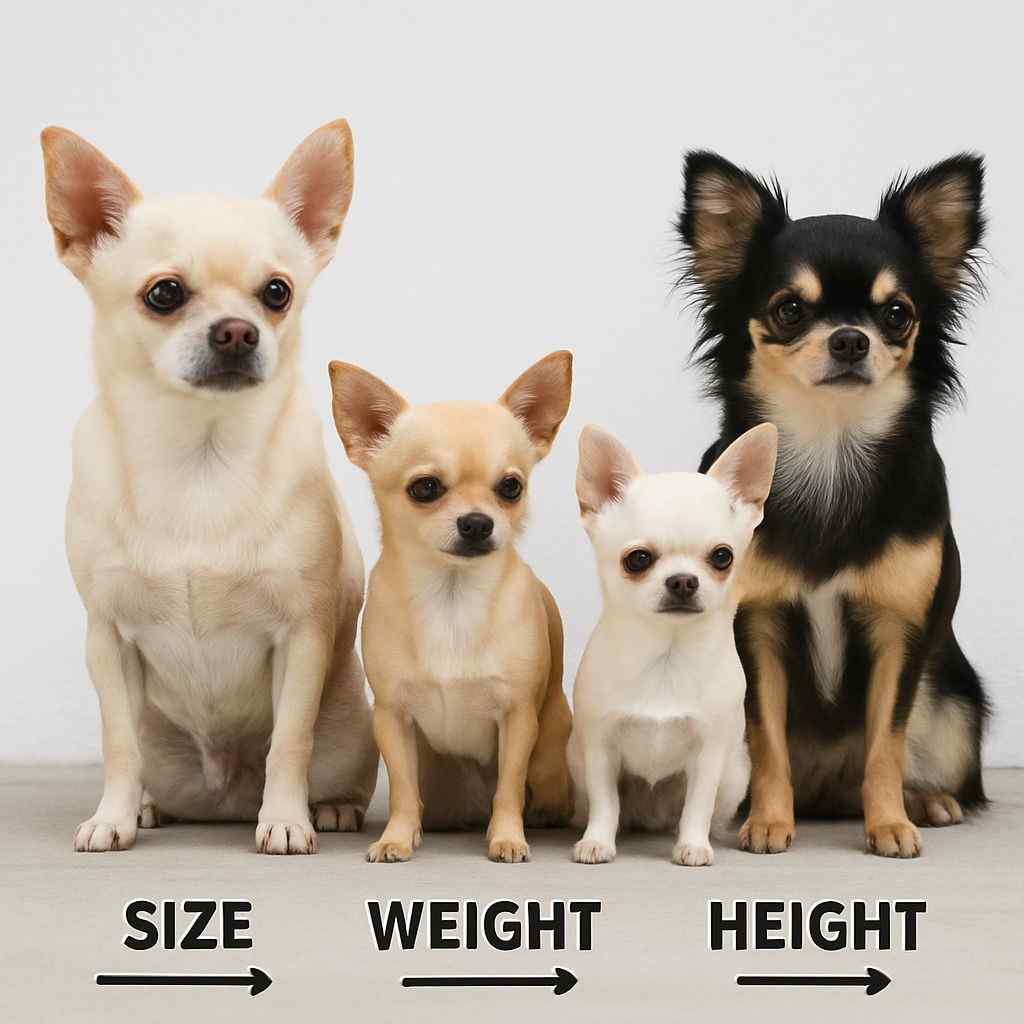
| Age | Average Weight (lbs) | Average Weight (kg) | Size (Height in inches) | Size (Height in cm) |
|---|---|---|---|---|
| Newborn | 0.3 – 0.5 lbs | 0.14 – 0.23 kg | 2 – 3 inches | 5 – 7.5 cm |
| 2 Weeks | 0.5 – 0.9 lbs | 0.23 – 0.4 kg | 2.5 – 3.5 inches | 6.3 – 8.9 cm |
| 1 Month | 1 – 1.5 lbs | 0.45 – 0.68 kg | 3.5 – 4.5 inches | 8.9 – 11.4 cm |
| 2 Months | 1.5 – 2.5 lbs | 0.68 – 1.13 kg | 4.5 – 5.5 inches | 11.4 – 14 cm |
| 3 Months | 2 – 3.5 lbs | 0.9 – 1.58 kg | 5 – 6 inches | 12.7 – 15.2 cm |
| 6 Months | 3 – 4.5 lbs | 1.36 – 2.04 kg | 5.5 – 7 inches | 14 – 17.8 cm |
| 9 Months | 4 – 5.5 lbs | 1.81 – 2.5 kg | 6 – 8 inches | 15.2 – 20.3 cm |
| 1 Year (Adult) | 4 – 6 lbs | 1.81 – 2.72 kg | 6 – 9 inches | 15.2 – 22.8 cm |
⚠️ Note: These are average estimates. Actual size and weight can vary depending on genetics, diet, health, and whether the Chihuahua is a teacup, standard, or mixed type.
- Average height: 5–8 inches
- Weight: 2–6 pounds
- Teacup variants: Under 3 pounds
Chihuahua Puppies Coat Types and Colors
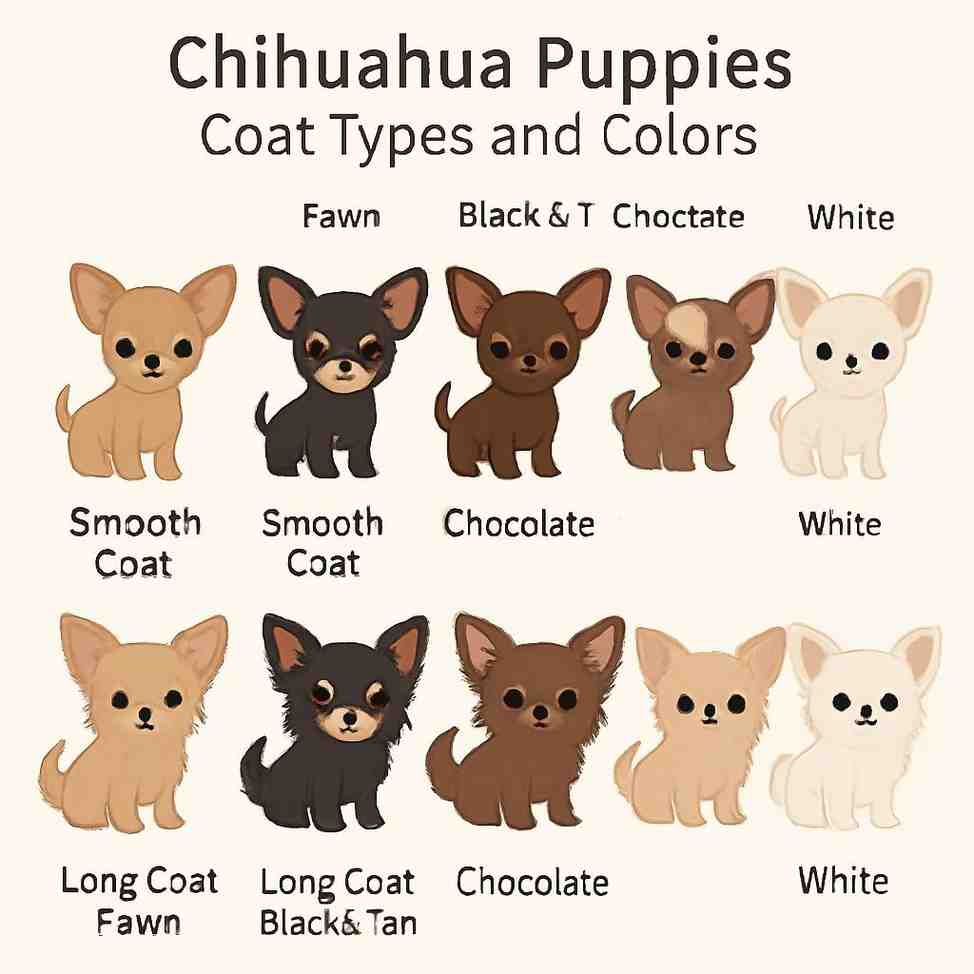
| Coat Type | Texture | Common Colors | Notes |
|---|---|---|---|
| Smooth Coat | Short, glossy, close to the body | Fawn, Black, White, Chocolate, Cream, Blue, Gold, Tan, Red | Requires minimal grooming; sleek and soft feel |
| Long Coat | Soft, fine, can be flat or slightly wavy | Black, White, Chocolate, Cream, Fawn, Red, Blue, Sable, Merle | Needs regular brushing; has an elegant, flowing look |
| Double Coat (seen in some long-haired types) | Dense undercoat with longer outer coat | Same as above (color range stays consistent) | Offers better insulation; sheds more |
| Wire Coat (rare or in mixed breeds) | Coarse, bristly texture | Variable; not standard in purebred Chihuahuas | More common in Chihuahua mixes (e.g., with Terriers) |
🎨 Popular Chihuahua Puppies Coat Patterns

| Pattern | Description |
|---|---|
| Solid | One uniform color (e.g., solid black, white, fawn) |
| Bicolor | Two-color mix, often white paired with black, brown, or fawn |
| Tricolor | Typically black, white, and tan |
| Merle | Mottled or speckled patches of color; often with blue eyes (note: controversial in breeding) |
| Brindle | Tiger-stripe appearance with streaks of different colors |
| Sable | Dark-tipped hairs over a lighter base color |
| Spotted on White | White base coat with large colored spots |
📝 Note: The American Kennel Club (AKC) accepts all colors and patterns for Chihuahuas, which makes them one of the most colorful dog breeds out there!
Long-Haired vs Short-Haired Chihuahuas Puppies

| Feature | Long-Haired Chihuahua | Short-Haired (Smooth Coat) Chihuahua |
|---|---|---|
| Coat Length | Long, soft, can be flat or slightly wavy | Short, smooth, glossy coat that lies close to the body |
| Grooming Needs | High – needs regular brushing to prevent tangles | Low – occasional brushing is enough |
| Shedding | Moderate – may shed in seasons | Low to moderate – sheds but not excessively |
| Appearance | More elegant, with a fluffy tail and fringe around ears | Sleek and neat appearance |
| Time to Full Coat | Can take up to 2 years for full coat to develop | Coat is fully developed by a few months old |
| Weather Tolerance | Slightly better insulation in cold weather | More sensitive to cold; may need sweaters in winter |
| AKC Recognition | Fully recognized as a standard coat type | Fully recognized as a standard coat type |
| Popularity | Popular for their cute, fluffy look | Popular for ease of care and classic Chihuahua style |
| Temperament Difference | None – coat type does not affect personality | None – same breed temperament |
| Best For | Owners who enjoy grooming and love a luxurious coat | Owners who prefer low-maintenance grooming |
Both long-haired and short-haired Chihuahuas are equally loving, loyal, and full of personality. The choice really comes down to your grooming preference and style!
Chihuahua Eyes, Ears, and Expression
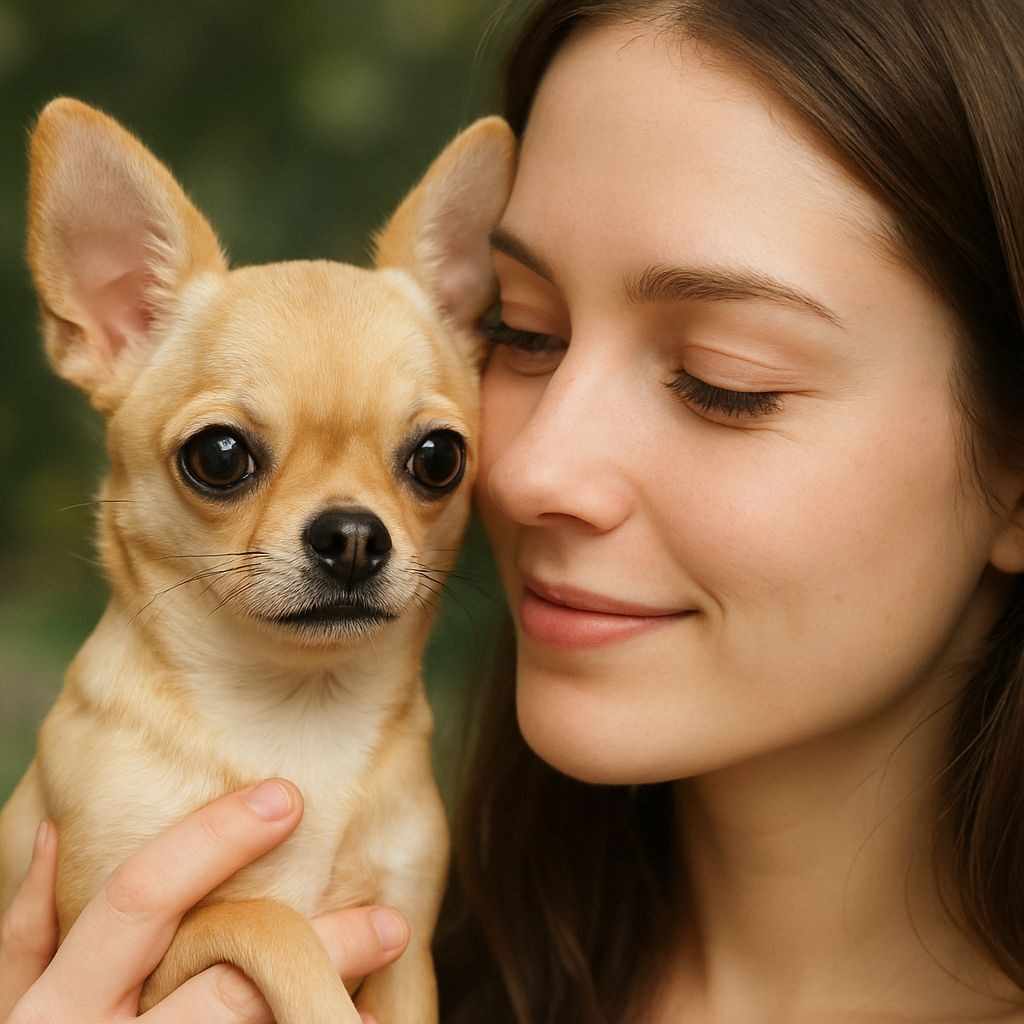
| Feature | Description |
|---|---|
| Eyes | Large, round, and very expressive. Often dark in color, but can be lighter in light-coated dogs. Occasionally, blue or heterochromia (two-colored eyes) is seen in merle Chihuahuas. |
| Eye Expression | Alert, intelligent, and full of curiosity. Their eyes often appear slightly “buggy” due to their size, but this adds to their charm. |
| Ears | Large, upright, and widely set apart. They stand tall and are very mobile, often twitching in response to sounds or emotions. |
| Ear Expression | Chihuahuas use their ears to communicate — perked up when alert or excited, laid back when relaxed or anxious. |
| Overall Expression | Bright, bold, and confident. Despite their small size, they often appear fearless, spunky, and full of attitude. |
| Unique Feature | Their face often looks like they’re judging the world — but in the cutest way possible! |
Personality Traits
Brave Hearts in Tiny Bodies
They don’t back down easily. These pups will bark at a dog ten times their size if they feel the need to defend their territory (or you!).
Loyalty and Bonding Behavior
Chihuahuas usually bond with one person and stick to them like glue. If you’re that lucky person, expect a forever shadow.
Socialization and Temperament
With proper training, they can be sweet and sociable. Without it? Let’s just say they’ll become the rulers of your house.
Why Chihuahuas Puppies Make the Perfect Pocket Pets
Portability and Convenience
Toss a blanket in your tote, and your Chihuahua’s ready to roll. They’re the perfect travel buddies.
Apartment-Friendly Nature
Don’t have a yard? No problem. A Chihuahua’s exercise needs are minimal, making them ideal for small spaces.
Easy Maintenance and Grooming
Short coats need little brushing. They don’t drool, shed moderately, and can be bathed quickly.
Chihuahua Puppies Care Guide

Nutrition Tips for Tiny Appetites
Chihuahuas may be tiny, but their nutritional needs are mighty! Because of their small stomachs and fast metabolisms, they need a balanced, energy-rich diet in small portions. Here’s how to keep those little bellies full and healthy:
🦴 1. Choose High-Quality Small-Breed Dog Food
| Tip | Look for formulas made specifically for small breeds – these have smaller kibble size and higher calorie content per bite. |
|---|---|
| Example | Reputed brands nearby should be prefered after consulting a vet. |
🧬 2. Focus on Protein and Fat
- Chihuahuas requires more protein than larger dogs to support their energy levels and muscle strength.
- Provide food with meat listed as the first ingredient (like chicken, beef, or fish).
- Healthy fats (like omega-3s) support skin, coat, and brain development.
⏱️ 3. Feed Small Meals Multiple Times a Day
| Age | Feeding Frequency |
|---|---|
| Puppies (under 6 months) | 3–4 meals daily |
| Adults (6 months and up) | 2–3 meals daily |
| Seniors | 2 meals daily (lower calorie needs) |
- Small, frequent meals help prevent hypoglycemia (a common risk in small breeds).
🚰 4. Always Provide Fresh Water
The amount can vary depending on activity level, temperature, health, and diet (dry food vs wet food).
| Age Group | Approximate Water Requirement per Day |
|---|---|
| Newborn Puppy (0–4 weeks) | Mostly gets water from mother’s milk; a few mL if hand-fed (around 10–20 mL per day if orphaned) |
| Weaning Puppy (4–8 weeks) | 50–80 mL per kg body weight (about 100–200 mL total) |
| Young Puppy (2–6 months) | 50–60 mL per kg body weight (about 150–300 mL total) |
| Adult (1–7 years) | 40–60 mL per kg body weight (about 120–250 mL total) |
| Senior (7+ years) | 40–50 mL per kg body weight (about 100–200 mL total) |
| Pregnant/Nursing Female | 70–100 mL per kg body weight (higher: 250–400 mL total) |
Notes:
✅ 1 kg = ~2.2 lbs.
✅ The average adult Chihuahua weighs 1.5–3 kg (3–6.5 lbs).
✅ Puppies and lactating females need more water relative to body weight.
✅ Always provide clean, fresh water throughout the day.
❌ 5. Avoid These Common Mistakes
| ❗ Mistake | 🚫 Why It’s Bad |
|---|---|
| Table scraps | Can cause obesity and upset stomachs |
| Overfeeding treats | Can unbalance their diet and cause weight gain |
| Skipping meals | Can cause low blood sugar, especially in puppies |
| Feeding large-breed food | Kibble size and nutrient levels are not appropriate |
🥦 6. Add Healthy Toppers (if possible)
| Topper | Benefits |
|---|---|
| Cooked chicken, turkey, or eggs | High-quality protein |
| Pumpkin puree | Aids digestion |
| Chia or flax seeds | Great for coat health |
| Shredded carrots or blueberries | Natural antioxidants |
📏 7. Monitor Weight and Body Condition
- You should be able to feel (not see) their ribs.
- Watch for signs of underweight (lethargy, visible spine) or overweight (no waist, difficulty walking).
- Adjust portion sizes gradually based on age and activity level.
💡 Pro Tip:
Chihuahuas are picky eaters with tiny tummies – make mealtime appealing with warm food, soft textures, and variety (but don’t overdo it!).
Exercise Needs of Chihuahuas by Age Group
| Age Group | Daily Exercise Duration | Type of Exercise | Notes |
|---|---|---|---|
| 0–3 Months (Puppy) | 5–10 minutes (indoor play) | Gentle play, short supervised walks indoors | Focus on safe play; avoid long walks or jumping due to bone development |
| 3–6 Months (Puppy) | 15–20 minutes | Light walks, fetch, social play with soft toys | Start leash training; keep sessions short and fun |
| 6–12 Months (Junior) | 20–30 minutes | Short walks, basic obedience training, puzzle toys | Build stamina slowly; avoid overexertion |
| 1–6 Years (Adult) | 30–45 minutes | Brisk walks, playtime, fetch, agility games | High energy at this stage – mental and physical stimulation is crucial |
| 7+ Years (Senior) | 15–30 minutes (adjusted) | Gentle walks, indoor play, scent work | Monitor for joint issues; low-impact activities preferred |
🐕🦺 Tips for Chihuahua Exercise:
- Always supervise outdoor play – Chihuahuas are small and vulnerable to predators.
- Avoid harsh weather – Their tiny size makes them sensitive to heat and cold.
- Use a harness, not a collar, during walks to protect their fragile neck.
- Mental stimulation (toys, puzzles) is just as important as physical exercise!
Short walks, indoor play, and mental games are plenty for keeping your Chihuahua pup happy.
Common Chihuahua Health Concerns and Prevention
| Health Concern | Description | Prevention/Tips |
|---|---|---|
| Hypoglycemia | Low blood sugar, especially in puppies. Causes weakness, shaking, or seizures. | Feed small, frequent meals. Avoid skipping meals. Keep a sugar source like honey handy for emergencies. |
| Luxating Patella | Dislocation of the kneecap, causing limping or skipping. | Avoid over-jumping. Maintain healthy weight. Vet check-ups for early signs. |
| Dental Disease | Plaque buildup, gum infections, tooth loss. Very common in small breeds. | Daily brushing, dental chews, and regular professional cleanings. |
| Tracheal Collapse | Weak trachea causes coughing and breathing trouble, worsened by pulling collars. | Use a harness instead of a collar. Keep weight under control. Avoid smoke/irritants. |
| Heart Disease (Mitral Valve Disease) | Common in older Chihuahuas; can cause fatigue, coughing. | Regular vet checkups, heart-healthy diet, early detection. |
| Obesity | Small size means even a few extra ounces can lead to health issues. | Monitor portions, avoid overfeeding treats, and ensure daily exercise. |
| Hydrocephalus | Abnormal fluid in the brain, more common in toy breeds. | No guaranteed prevention. Buy from reputable breeders who screen for it. |
| Eye Issues (e.g., dry eye, cataracts) | Bulging eyes are prone to dryness, injury, and age-related problems. | Keep eyes clean. Use vet-recommended drops if needed. Annual eye exams recommended. |
| Collapsed Fontanel (Open Skull) | Soft spot on the head that doesn’t close fully. Can be vulnerable to trauma. | Handle with care, especially in puppies. Avoid rough play. |
| Allergies (food or environmental) | Itchy skin, ear infections, or digestive upset. | Use limited-ingredient diets. Avoid known allergens. Regular vet testing if needed. |
🐶 Pro Tips:
- Annual check-ups are essential—even tiny dogs can hide big problems.
- Buy from reputable breeders who screen for genetic issues.
- Keep a health record log of vet visits, vaccines, and symptoms for better tracking.
Training a Chihuahua Puppy
🧠 1. Start Early, Start Small
- Begin basic training as early as 8 weeks old.
- Keep sessions short and sweet—5 to 10 minutes is perfect.
- Use positive reinforcement (treats, praise, toys).
🏆 2. Socialization is Key
- Expose your puppy to different people, sounds, and environments during the early months.
- Take short car rides, meet calm dogs, visit parks (in arms if needed).
- Helps prevent fear-based aggression and shyness later.
🍗 3. Use High-Value Treats
- Chihuahuas respond well to tiny, tasty rewards.
- Use treats like boiled chicken, cheese bits, or commercial training treats.
- Make sure they’re small and low-calorie to avoid overfeeding.
🚽 4. Potty Training Must Be Consistent
- Take your pup out every 1–2 hours, especially after eating or waking up.
- Use a command like “Go potty” and reward instantly after success.
- Be patient—Chihuahuas are known for being a bit stubborn with house training.
- Consider using pee pads indoors, especially in apartments.
📣 5. Teach Basic Commands
Start with these core commands:
- Sit 🪑
- Stay ⏸️
- Come 👋
- Leave it 🚫
- No 🙅♂️
Use clear words and repeat daily in a calm tone.
🐕 6. Avoid Yelling or Punishment
- Chihuahuas are sensitive and may become anxious with harsh discipline.
- Correct unwanted behavior with redirecting and positive alternatives.
📦 7. Crate Training is Helpful
- A crate can be your Chihuahua’s safe space, not a punishment.
- Great for potty training and travel.
- Choose a soft, cozy crate that fits their small size.
🐶 8. Curb Barking Early
- Chihuahuas are natural watchdogs and love to bark.
- Train a “quiet” command with reward-based training.
- Avoid accidentally reinforcing barking by comforting them when they do it.
💖 9. Bond Through Play and Training
- Combine learning with playtime using toys, puzzle games, and agility tunnels.
- This keeps your pup mentally stimulated and prevents boredom.
🐾 10. Be Patient and Stay Positive
- Every Chihuahua learns at their own pace.
- Celebrate small wins, and don’t expect perfection overnight.
- Consistency is more important than intensity!
Fun Facts About Chihuahuas Puppies
- A Chihuahua named Miracle Milly holds the record for smallest dog at just 3.8 inches tall.
- Paris Hilton made Chihuahuas a pop culture icon.
- Some Chihuahuas prefer blankets over beds—burrowing is their thing!
Comparing Chihuahuas Puppies with Other Small Breeds
| Breed | Avg Weight | Lifespan | Grooming Needs | Bark Level |
|---|---|---|---|---|
| Chihuahua | 2–6 lbs | 14–17 yrs | Low–Medium | High |
| Pomeranian | 3–7 lbs | 12–16 yrs | High | High |
| Yorkshire Terrier | 4–7 lbs | 13–16 yrs | Medium | High |
| French Bulldog | 16–28 lbs | 10–14 yrs | Low | Low–Medium |
Deer Head Chihuahua – A Unique Variant of the Smallest Dog Breed
The Deer Head Chihuahua is a variation of the Chihuahua breed, known for its distinctive longer snout and more sloped forehead, resembling the head of a young deer. While not officially recognized as a separate breed by major kennel clubs like the AKC, it remains popular for its unique looks and charming personality.
📋 Deer Head Chihuahua Puppies
| Feature | Details |
|---|---|
| Head Shape | Sloped forehead, long muzzle – resembles a deer’s head |
| Ear Shape | Large, upright, and alert |
| Body Type | Slightly larger and more muscular than apple heads |
| Weight Range | 4 – 7 lbs (1.8 – 3.2 kg), but some may be a bit larger |
| Height Range | 6 – 12 inches (15 – 30 cm) |
| Coat Types | Both short-haired and long-haired varieties |
| Colors Available | Fawn, chocolate, black, white, cream, sable, and more |
| Temperament | Loyal, alert, playful, bold, occasionally stubborn |
| Lifespan | 14 – 17 years (with proper care) |
| Breed Status | Not show-eligible by AKC standards (only Apple Head qualifies) |
🐶 Personality Traits
- Very protective and often attached to one person
- Can be wary of strangers without proper socialization
- Full of confidence, despite their tiny size
- Known for being smart but stubborn – requires patient training
🆚 Deer Head vs Apple Head Chihuahua Puppies
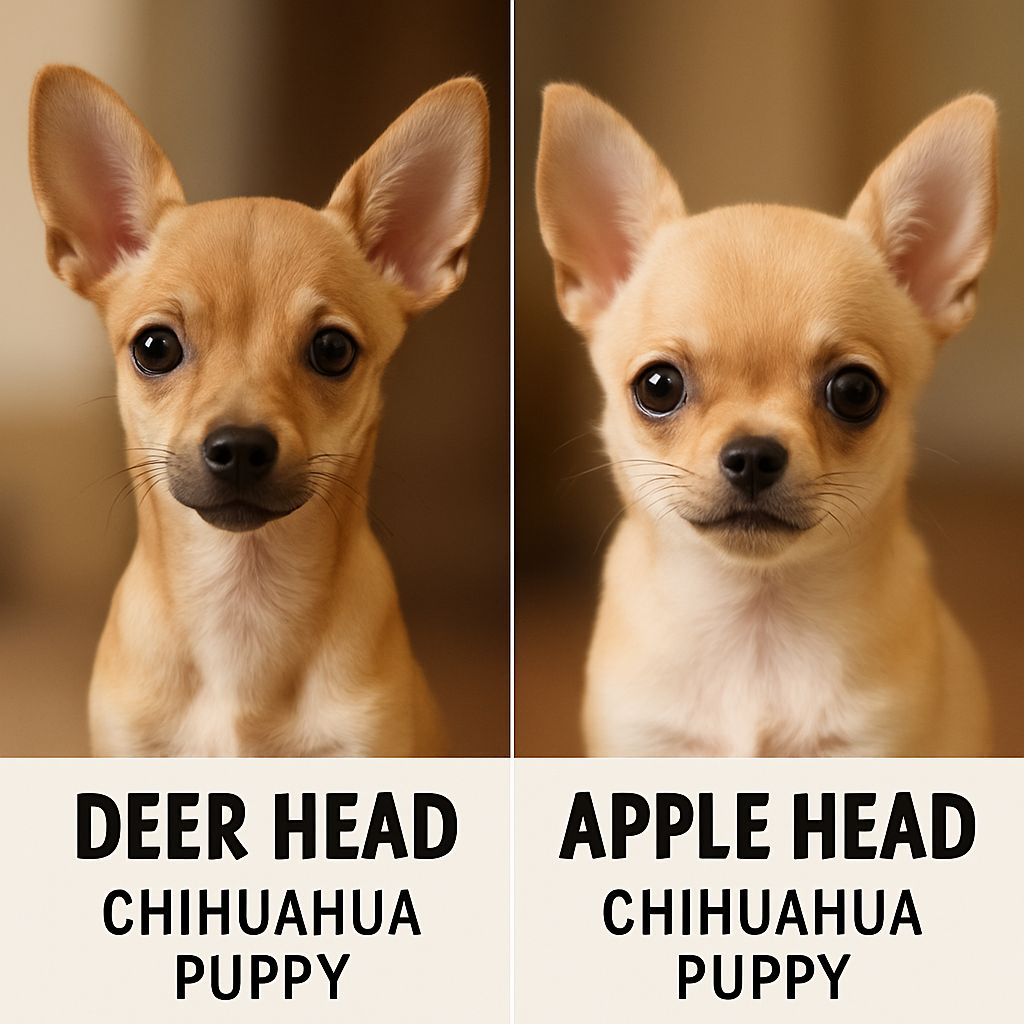
| Trait | Deer Head Chihuahua | Apple Head Chihuahua |
|---|---|---|
| Skull Shape | Sloped like a deer | Round, apple-like dome |
| Muzzle | Long and narrow | Short and stubby |
| Body Size | Slightly larger | Smaller and more compact |
| AKC Recognition | Not standard | Recognized breed standard |
| Temperament | Often calmer | More energetic and vocal |
🔍 Fun Fact
The Deer Head Chihuahua is believed to be more closely related to the ancient Techichi dogs kept by the Toltecs in Mexico!
Mix Breeds Of Chihuahua
Chihuahua Pitbull Mix (Chipit)
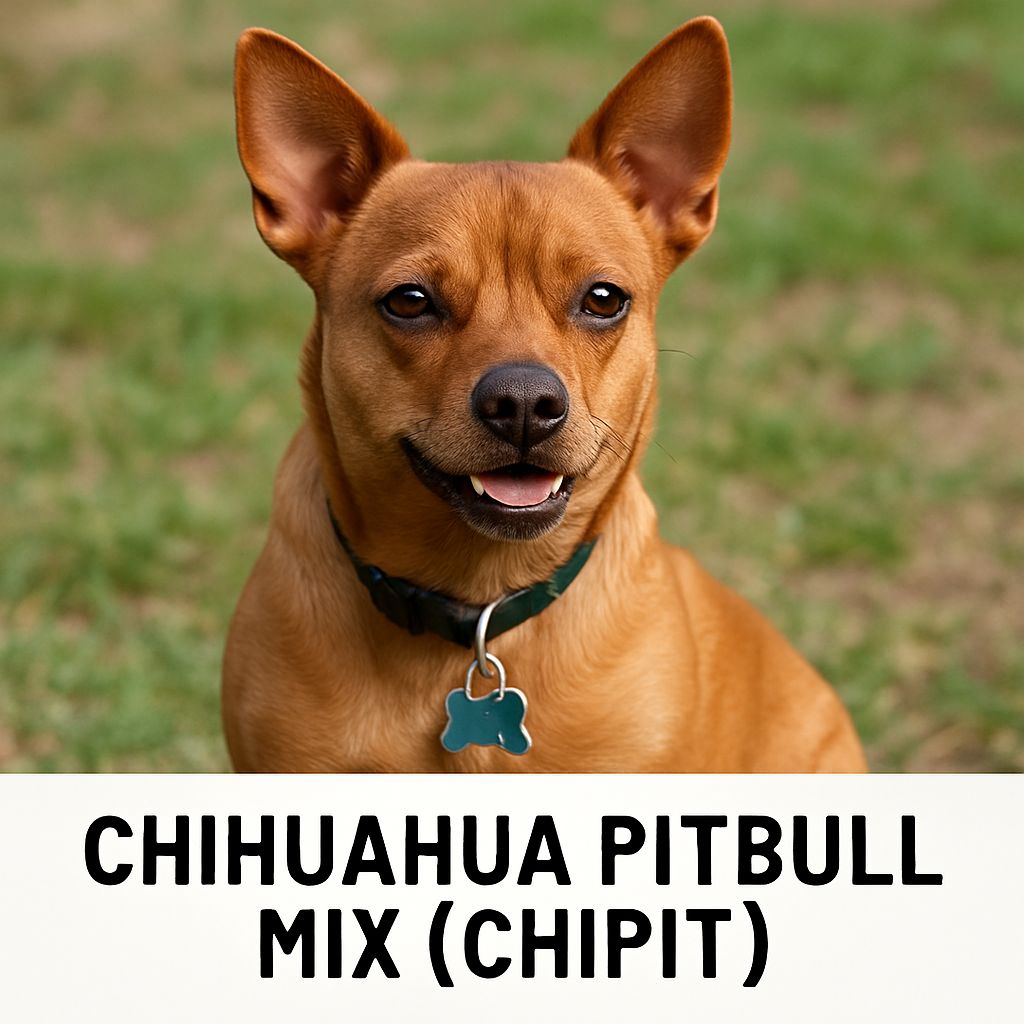
| Characteristic | Chihuahua | Pitbull Chihuahua Mix (Chipit) |
|---|---|---|
| Size | Tiny (2–6 lbs, 6–9 inches tall) | Small to medium (10–35 lbs, 12–18 inches tall) |
| Temperament | Loyal, alert, sassy, often bonds with one owner | Loyal, energetic, protective; may be feisty or stubborn |
| Lifespan | 12–20 years (AKC, 2024) | 10–15 years (based on parent breeds, AKC 2024) |
| Grooming Needs | Low to moderate; smooth or long coat, weekly brush | Low to moderate; short coat, weekly brushing |
| Exercise Needs | Low; 20–30 minutes daily (short walks, playtime) | Moderate; 30–60 minutes daily (walks, playtime) |
| Health Concerns | Dental issues, patellar luxation, hypoglycemia | Dental issues, hip dysplasia, obesity if overfed |
| Trainability | Moderate; stubborn but responds to positive reinforcement | Moderate; intelligent but may inherit Chihuahua stubbornness |
| Good for | Apartments, small spaces, single owners | Active owners, families with older kids, apartments (with exercise) |
Chihuahua Terrier Mix
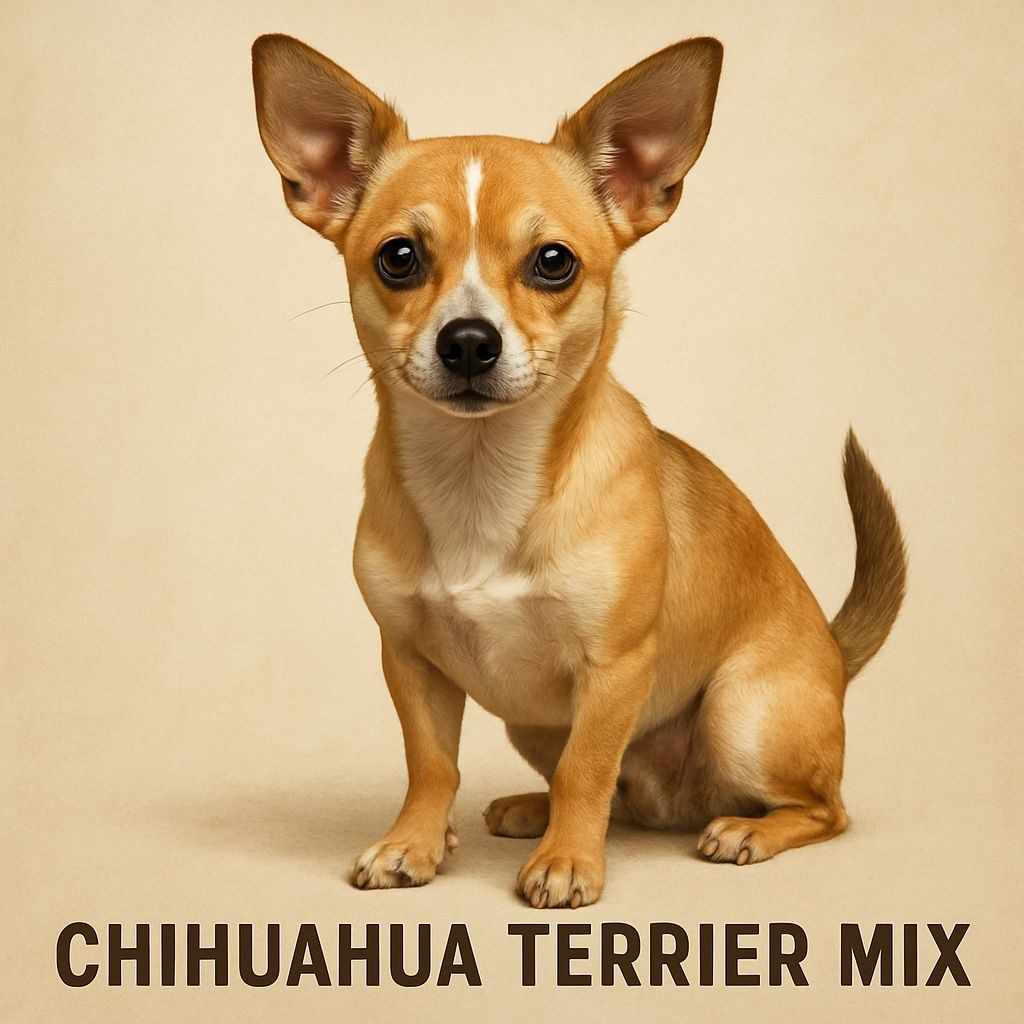
| Characteristic | Chihuahua | Chihuahua Terrier Mix |
|---|---|---|
| Size | Tiny (2–6 lbs, 6–9 inches tall) | Small (4–15 lbs, 10–15 inches tall, varies by terrier) |
| Temperament | Loyal, alert, sassy, often bonds with one owner | Energetic, feisty, intelligent; may be more social |
| Lifespan | 12–20 years (AKC, 2024) | 12–18 years (based on parent breeds, AKC 2024) |
| Grooming Needs | Low to moderate; smooth or long coat, weekly brush | Low to moderate; short to wiry coat, weekly brushing |
| Exercise Needs | Low; 20–30 minutes daily (short walks, playtime) | Moderate; 30–60 minutes daily (walks, playtime) |
| Health Concerns | Dental issues, patellar luxation, hypoglycemia | Dental issues, allergies, patellar luxation |
| Trainability | Moderate; stubborn but responds to positive reinforcement | Moderate; intelligent but can be stubborn or independent |
| Good for | Apartments, small spaces, single owners | Active owners, families, apartments (with exercise) |
Jack Russell Chihuahua Mix (Jack Chi)
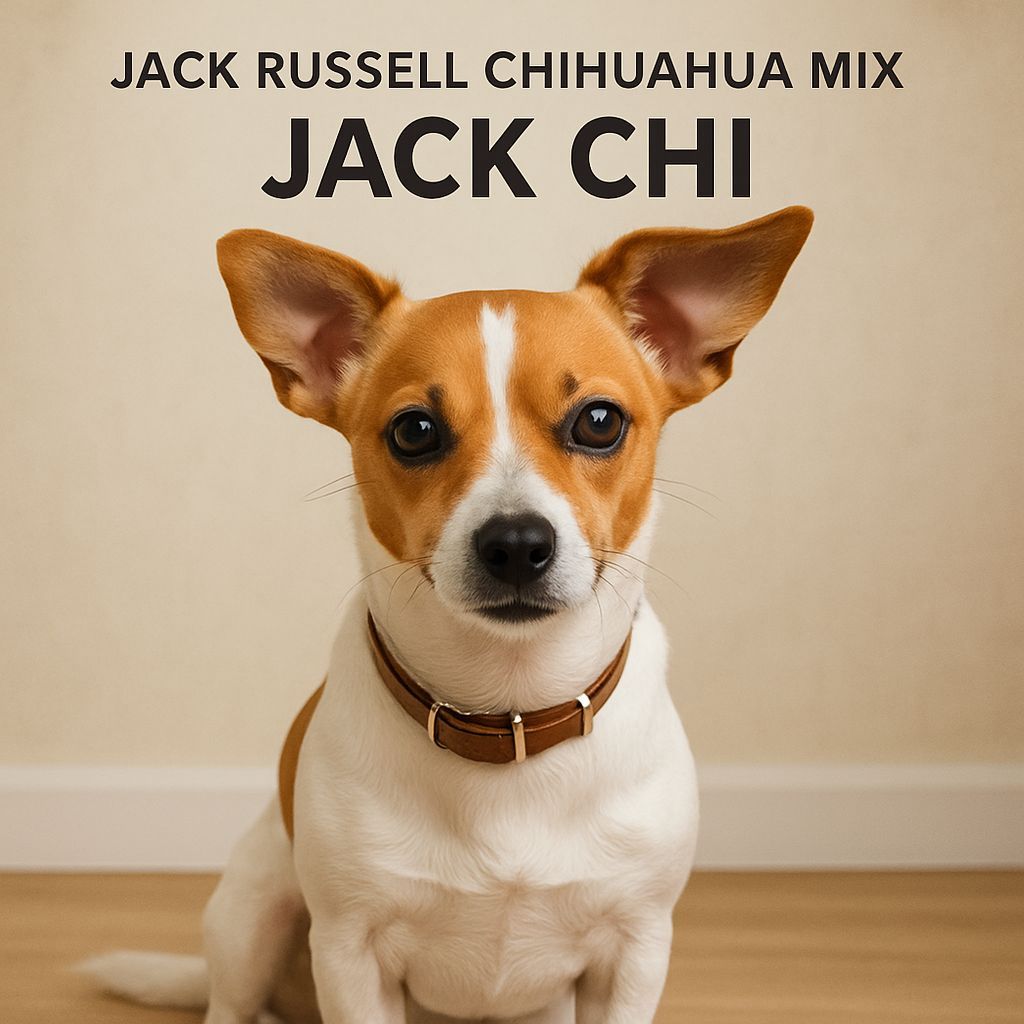
| Characteristic | Chihuahua | Jack Russell Chihuahua Mix (Jack Chi) |
|---|---|---|
| Size | Tiny (2–6 lbs, 6–9 inches tall) | Small (4–15 lbs, 10–15 inches tall) |
| Temperament | Loyal, alert, sassy, often bonds with one owner | Energetic, playful, intelligent; more social |
| Lifespan | 12–20 years (AKC, 2024) | 12–18 years (based on parent breeds, AKC 2024) |
| Grooming Needs | Low to moderate; smooth or long coat, weekly brush | Low to moderate; short coat, weekly brushing |
| Exercise Needs | Low; 20–30 minutes daily (short walks, playtime) | High; 45–60 minutes daily (walks, active play) |
| Health Concerns | Dental issues, patellar luxation, hypoglycemia | Dental issues, patellar luxation, eye problems |
| Trainability | Moderate; stubborn but responds to positive reinforcement | Moderate; intelligent but can be willful |
| Good for | Apartments, small spaces, single owners | Active owners, families, homes with space to play |
Pomeranian Chihuahua Mix
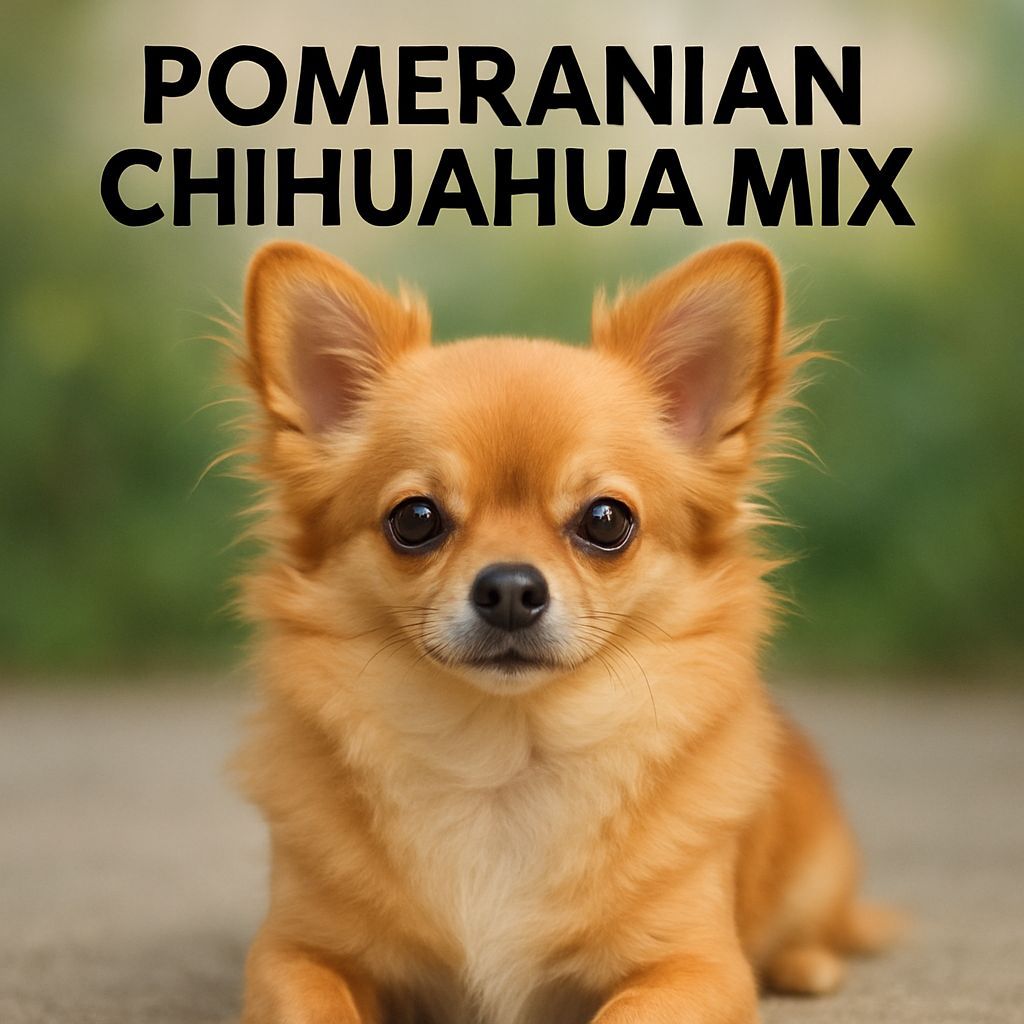
| Characteristic | Chihuahua | Pomeranian Chihuahua Mix (Pomchi) |
|---|---|---|
| Size | Tiny (2–6 lbs, 6–9 inches tall) | Small (3–10 lbs, 6–12 inches tall) |
| Temperament | Loyal, alert, sassy, often bonds with one owner | Playful, affectionate, spirited; may be less reserved |
| Lifespan | 12–20 years (AKC, 2024) | 12–18 years (based on parent breeds, AKC 2024) |
| Grooming Needs | Low to moderate; smooth or long coat, weekly brush | Moderate to high; fluffy coat, frequent brushing |
| Exercise Needs | Low; 20–30 minutes daily (short walks, playtime) | Moderate; 30–45 minutes daily (walks, playtime) |
| Health Concerns | Dental issues, patellar luxation, hypoglycemia | Dental issues, tracheal collapse, luxating patella |
| Trainability | Moderate; stubborn but responds to positive reinforcement | Moderate; intelligent but can be stubborn |
| Good for | Apartments, small spaces, single owners | Apartments, families, owners with grooming time |
How Much Does A Chihuahua Cost
| Expense Type | Chihuahua (USD) | Chihuahua (INR) | Pomchi (USD) | Pomchi (INR) |
|---|---|---|---|---|
| Initial Purchase (Breeder) | $500–$3,000 | ₹42,250–₹253,500 | $400–$2,500 | ₹33,800–₹211,250 |
| Adoption (Shelter/Rescue) | $50–$400 | ₹4,225–₹33,800 | $50–$400 | ₹4,225–₹33,800 |
| Monthly Food | $15–$30 | ₹1,268–₹2,535 | $15–$35 | ₹1,268–₹2,958 |
| Monthly Grooming (Home) | $5–$10 | ₹423–₹845 | $10–$15 | ₹845–₹1,268 |
| Monthly Grooming (Professional) | $30–$50 | ₹2,535–₹4,225 | $40–$60 | ₹3,380–₹5,070 |
| Monthly Training | $10–$50 | ₹845–₹4,225 | $10–$50 | ₹845–₹4,225 |
| Annual Vet Costs | $100–$300 | ₹8,450–₹25,350 | $100–$350 | ₹8,450–₹29,575 |
| First-Year Vaccinations | $70–$150 | ₹5,915–₹12,675 | $70–$150 | ₹5,915–₹12,675 |
| Spaying/Neutering | $100–$200 | ₹8,450–₹16,900 | $100–$200 | ₹8,450–₹16,900 |
Celebrities Having Chihuahua Puppies As Companion
| Celebrity Name | Country |
|---|---|
| Paris Hilton | USA |
| Britney Spears | USA |
| Madonna | USA |
| Reese Witherspoon | USA |
| Demi Moore | USA |
| Sharon Osbourne | UK |
| Paula Abdul | USA |
| Mickey Rourke | USA |
| Jennifer Love Hewitt | USA |
| Hilary Duff | USA |
| Alyssa Milano | USA |
| Marilyn Monroe (historical) | USA |
| Kelly Osbourne | UK |
| Scarlett Johansson | USA |
| Geri Halliwell (Spice Girls) | UK |
| Mariah Carey | USA |
| Christina Ricci | USA |
| Anushka Sharma | India |
| Priyanka Chopra Jonas | India / USA |
| Sonam Kapoor | India |
🐾 Many of these stars have been photographed with their Chihuahuas at events or even carried them in designer bags!
Alternative/Local Names For The Chihuahua
While the breed is officially called Chihuahua everywhere (named after the Mexican state), in local languages and cultures people sometimes use affectionate, descriptive, or slang names for them.
| Country | Alternative/Local Name |
|---|---|
| Mexico | Chihuahueño, Chiquito, Perrito Bolsa (“purse dog”) |
| USA | Chi, Chi-chi, Pocket Dog |
| UK | Chi, Tiny Dog |
| France | Chichuahua (phonetic), Petit Chien |
| Germany | Chihuahua (same), Taschenhund (“bag dog”) |
| Italy | Chihuahua (same), Cane Chihuahua, Piccolo Cane (“small dog”) |
| Spain | Chihuahueño, Perrito, Enanito (“little dwarf”) |
| Japan | チワワ (Chiwawa), Chi-chan |
| China | 吉娃娃 (Jíwáwá – sounds like Chihuahua) |
| Brazil | Chihuahua, Cachorrinho de Bolsa (“purse dog”) |
| Russia | Чихуахуа (Chikhuakhua), Чи (Chi) |
| India | Chi, Toy Dog, Mini Dog |
| Philippines | Chihuahua (same), Kuting Aso (“puppy-like dog”) |
| Thailand | ชิวาวา (Chiwawa), หมาน้อย (Maa Noi — “little dog”) |
| Korea | 치와와 (Chiwawa), 작은 강아지 (Jageun Gangaji — “small puppy”) |
| Turkey | Chihuahua, Çanta Köpeği (“bag dog”) |
| Argentina | Chihuahua, Perrito Bolsita (“little bag dog”) |
| Egypt | Chihuahua, Kalb Soghayar (“small dog”) |
| South Africa | Chi, Pocket Pup |
These names reflect both the pronunciation adaptations of “Chihuahua” in different languages and affectionate nicknames referencing their tiny size and popularity as a “lap” or “purse” dog.
Conclusion
Chihuahua puppies may be the smallest dog breed in the world, but don’t let their size fool you. These tiny dogs pack a huge personality into a little body. Known for their sass, smarts, and loyalty, Chihuahuas are among the top picks for city dwellers and pet lovers alike. Let’s explore what makes this tiny Chihuahua breed so fierce and lovable.
FAQs About Chihuahuas Puppies
What is the average size of a Chihuahua puppy when fully grown?
Adult Chihuahuas usually weigh between 2 to 6 pounds and stand about 6 to 9 inches tall. They’re one of the smallest dog breeds in the world.
How long do Chihuahua puppies live?
With proper care, Chihuahuas can live 12 to 20 years. Good nutrition, regular vet checkups, and dental care help them reach the higher end of that range.
Are Chihuahua puppies good with children?
They can be, but due to their small size and delicate build, supervision is essential around young kids to prevent accidental injury.
How often should I feed my Chihuahua puppy?
Puppies need 3–4 small meals per day. Because of their tiny stomachs, frequent feeding prevents low blood sugar (hypoglycemia).
Do Chihuahua puppies shed a lot?
They shed moderately year-round. Smooth-coated Chihuahuas shed less than long-haired ones. Regular brushing helps manage loose hair.
Do Chihuahua puppies bark a lot?
Yes, they’re naturally alert and tend to bark at unfamiliar sounds or strangers. Consistent training can help reduce excessive barking.
How much exercise do Chihuahua puppies need?
Short daily walks and indoor play are enough. They tire easily but still need activity to stay fit and mentally stimulated.
Are Chihuahuas good apartment dogs?
Absolutely. Their small size makes them ideal for apartments, as long as they get enough attention and exercise.
What common health problems affect Chihuahua puppies?
They may face issues like dental disease, patellar luxation (knee problems), heart murmurs, and hypoglycemia. Regular vet visits are important.
Can I leave my Chihuahua puppy alone at home?
They don’t like being alone for long periods. Separation anxiety is common, so gradual independence training helps.
How can I keep my Chihuahua warm in cold weather?
Because of their tiny size and thin coat, they get cold easily. Use warm clothing and limit outdoor time during winter.
When should I start training my Chihuahua puppy?
Start basic obedience and house training as early as 8 weeks. The earlier they learn routines, the better their behavior becomes.
How can I socialize my Chihuahua puppy?
Expose them to different people, pets, and environments gradually. Early socialization helps reduce fear and aggression later in life.
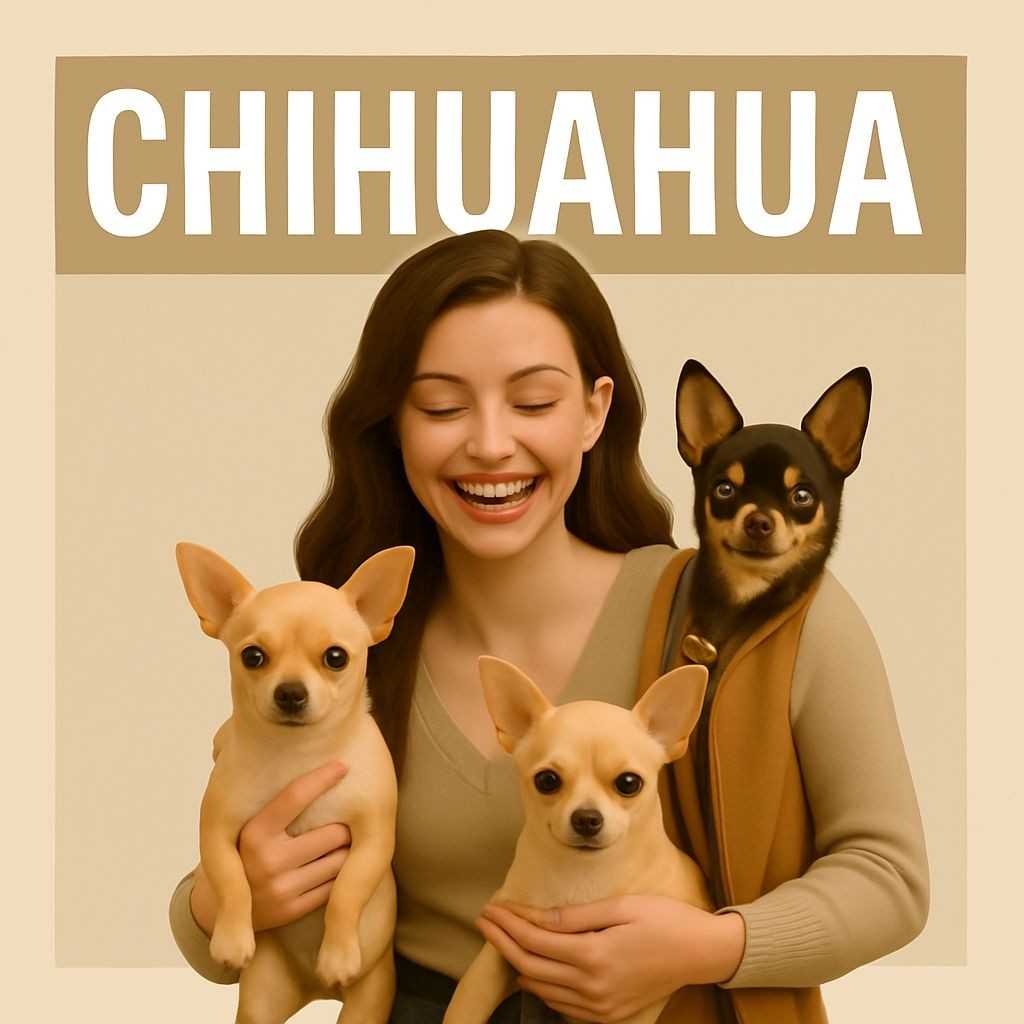
Appreciating the dedication you put into your blog and in
depth information you offer. It’s great to come across a blog every
once in a while that isn’t the same unwanted rehashed information.
Wonderful read! I’ve saved your site and I’m including your RSS feeds to my Google account.